
MichBio U: EHS Regulatory Overview for Labs
January 20, 2021 | 11 am – 12 pm ET
Cost: FREE for members, $19 for nonmembers
Join KTL Senior Consultant Liz Hillgren and MichBio for a high-level overview of the EHS regulations that might be applicable to laboratories. The webinar will discuss typical lab regulatory challenges and provide an overview of the major requirements for OSHA, EPA, and DOT compliance, including plans, reporting, training, and programs.
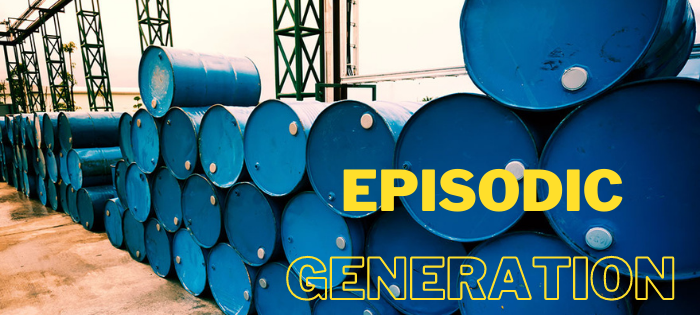
Comments: No Comments
How Episodic Generation Works
The Environmental Protection Agency (EPA) has provided generators of hazardous waste some options for managing unanticipated waste events and large-scale cleanouts that have not be acceptable in the past. Under the Hazardous Waste Generator Improvement Rule, episodic generation allows small quantity generators (SQGs) and very small quantity generators (VSQGs) of hazardous waste to maintain their generator status, even if they have an occurrence of waste generation that would normally push them into a higher generator status.
It is a fairly straightforward concept, in theory, that allows VSQGs and SQGs the flexibility to have one planned (e.g., regular maintenance, tank cleanouts, short-term projects, removal of excess chemical inventory, or chemical cleanouts) or unplanned (e.g., production process upsets, product recalls, accidental spills, acts of nature) event per year that creates an increase in the generation of hazardous wastes that exceeds quantity limits for the generator’s usual status.
If—or when—an episodic generation event occurs, there are very specific requirements that must be followed. KTL has assisted many companies through this process with great success, resulting in minimized risk, less threat of negative inspection results, and overall cleaner facilities. The case study below walks through an actual unplanned event and how the facility responded to maintain compliance with its SQG status.
Case Study: Episodic Generation Event
An Iowa company has a printing process that generates contaminated (used) solvent when it cleans its press and changes ink colors. Because the company generates more than 220 pounds (100 kilograms) but less than 2,200 pounds (1,000 kilograms) of hazardous waste per month, it is considered an SQG.
The company uses new and recycled solvent to formulate their inks for printing and to clean the press between printing runs. A distillation unit onsite is used to process used solvent for re-use in the processes.
Processing Breakdowns
During the first week of August, the company experienced two processing breakdowns that resulted in the unplanned generation of large quantities of hazardous waste:
- A piece of production equipment malfunctioned and contaminated all the ink in the facility and the press with microscopic ceramic fragments.
- Within the same week, the distillation unit had a thermocouple malfunction, and the used solvent began to accumulate.
These dual challenges resulted in a large generation event of excess contaminated waste ink and used solvent. The facility surpassed the SQG hazardous waste threshold quantities. An event such as this falls under the category of an unplanned episodic generation event. The company determined it needed to conduct an episodic generation cleanup event and set a goal of disposing of all hazardous waste by the end of August.
Steps to Compliance
As a first step, the company notified the EPA by phone within 72 hours of the event. The company also completed the initial notification form required by EPA requesting a one-time episodic event that would increase their generator status to LQG for the month and submitted it. Then, they began the coordination for disposal with the disposal facility and the transporter.
The facility disposed of all contaminated ink and solvent generated the first week of August by August 27 (within the 60-day requirement). During this time, the presses were flushed, the distillation unit was repaired, the facility began production, and the solvent recycling process resumed.
After all waste was disposed from the property, the company completed the final notification form for the EPA and returned to SQG generation levels by September 1. All manifests, land disposal notifications, and documentation are retained in an episodic generation file onsite. Additionally, KTL assisted in the development of a comprehensive overview document that explained all aspects of the episodic event so any future inspections would be completed with little question or concern about the event.
Requirements
An event such as the one described in this case study is a prime example of an unplanned episodic generation event. Accordingly, the facility was required to respond. Among the most significant requirements the facility had to satisfy to maintain its SQG status include:
- Notifying the EPA within 72 hours after an unplanned event (or at least 30 days before a planned event) using EPA Form 8700-12.
- Obtaining an EPA ID number (if the generator does not already have one) BEFORE initiating the shipment of generated waste.
- Completing the event and shipping the episodic waste off site within 60 days of starting the event, whether planned or unplanned, using a hazardous waste manifest, hazardous waste transporter, and RCRA-designated facility.
- Completing and maintaining records onsite for three years after the completion date of the episodic event.
Additional Details
It is important to note some additional details about episodic generation that are important for VSQGs and SQGs to know and understand:
- Typically, a generator is only allowed to have one episodic event per year, whether planned or unplanned; however, the generator may petition the EPA or state for a second event, provided the second event is the opposite type (i.e., planned vs. unplanned). The petition must include:
- Reason for and nature of the event
- Estimated amount of hazardous waste being managed
- How the hazardous waste will be managed
- Estimated length of time needed to complete the management, not to exceed 60 days
- Information regarding the previous episodic event (e.g., nature of the event, planned or unplanned, how the generator complied)
- An episodic event cannot last more than 60 days beginning on the first day episodic hazardous waste is generated and concluding on the day the hazardous waste is removed from the generator’s site. If the hazardous waste is not off site within 60 days, then it must be counted toward the generator’s monthly generation levels.
- The following are NOT considered episodic events and would impact overall generator status:
- Increased waste related to increased production
- An accident or spill due to operator error, abuse, or lack of maintenance (i.e., irresponsible management of hazardous waste/materials)
- Any activity that is part of the normal course of business
- Discovering at the end of the month that the monthly generation thresholds have been exceeded
- Short-term generation differs from episodic generation. A short-term generator is an entity that does not normally generate hazardous waste but has a one-time, non-recurring, temporary event (typically less than 90 days) unrelated to normal operational activities. Short-term generators are not relieved of any regulatory requirements tied to the volume of hazardous waste generated and must meet all generator requirements for the level of generator (i.e., notification, manifesting, reporting, contingency planning, and training).
The episodic waste provision allows SQGs and VSQGs to avoid the increased burden of a higher generator status when generating episodic waste—provided it is properly managed. In the past, this wasn’t an option, unless states provided special exception. Now it is part of EPA’s objective to provide greater flexibility in how hazardous waste is managed through the Hazardous Waste Generator Improvements Rule. If your company is interested in exploring a plant-wide chemical cleanup or experiences a production challenge that results in the generation of hazardous waste at a rate that is higher than your generator status allows, KTL can provide the expertise necessary to guide you through the episodic generation process.
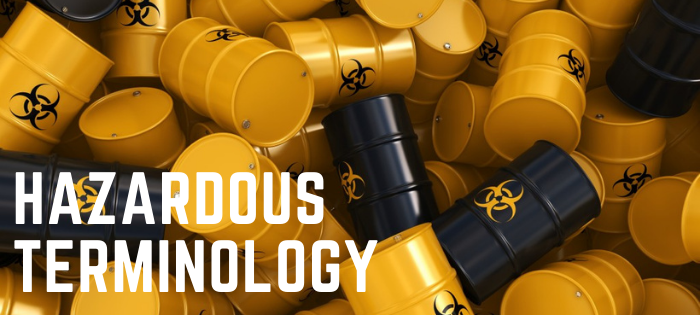
Comments: No Comments
Understanding Hazardous Terminology
When it comes to regulatory compliance, “hazardous” is an important term. Unfortunately, what is considered “hazardous” can be very confusing with the varying hazardous terms and definitions used across multiple regulatory agencies.
Overlapping Terminology
The fact is that different regulations have different definitions for similar terms, and these regulations are applied for different purposes. The same material can take on multiple descriptors—or not—depending on which regulations apply:
- Environmental Protection Agency (EPA) uses the term hazardous waste to protect human health and the environment (40 CFR 261 and 268).
- Department of Transportation (DOT) uses the term hazardous materials to ensure materials are managed safely in all modes of transport—air, road, marine, and rail (49 CFR 172).
- Occupational Safety and Health Administration (OSHA) uses the term hazardous substances and focuses on worker safety (29 CFR).
Sometimes, this terminology overlaps; sometimes it doesn’t. That is why it is critical to understand the differences between hazardous terms and to use each term appropriately—so you know what requirements apply.
EPA: Hazardous Waste
According to EPA, a hazardous waste is “a contaminated chemical or byproduct of a production process that no longer serves its purpose and needs to be disposed of in accordance with the EPA.”
Hazardous waste is generated from many sources, ranging from industrial manufacturing process wastes to batteries, and may come in many forms (e.g., liquids, solids, gases, and sludges). To determine whether a waste is considered “hazardous,” EPA has developed a flowchart identification process (pictured below).
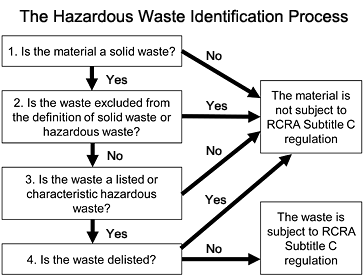
EPA’s Resource Conservation and Recovery Act (RCRA) establishes the regulatory framework for managing hazardous waste. The degree of regulation that applies to each hazardous waste generator depends on the amount of hazardous waste produced.
Unless it is managed at the facility, hazardous waste generated must eventually be transported off site for disposal, treatment, or recycling. At this point, DOT regulations kick in for the transportation of freight, including the transport of RCRA hazardous waste.
DOT: Hazardous Material
DOT has the authority to regulate the transportation of hazardous materials under the Hazardous Materials Transportation Act (HMTA), which is overseen by the Pipeline and Hazardous Materials Safety Administration (PHMSA) division of DOT. A DOT hazardous material is defined as “a substance (gas, liquid, or solid) capable of creating harm to people, environment, and property.”
By definition, hazardous materials are capable of posing an unreasonable risk to health, safety, and property in commerce. This includes substances, wastes, marine pollutants, elevated temperature materials, and items included in DOT’s Hazardous Materials Table (HMT – 49 CFR 172.101) (e.g., laboratory chemicals, solvents, alcohol, acids, compressed gases, cleaners, pesticides, paints, infectious substances, radioactive materials). Note that anything excluded from the EPA’s Hazardous Waste Manifest requirements is not considered a hazardous waste by DOT when shipped but may be considered a hazardous material. This is a tricky nuance but very important for shippers to understand. Correspondingly, DOT has rigorous training requirements.
Hazardous materials are legally defined by class, characteristic, and name:
- Class 1: Explosives
- Class 2: Gases
- Class 3: Flammable Liquid
- Class 4: Flammable Solids
- Class 5: Oxidizing Substances, Organic Peroxides
- Class 6: Poisonous (Toxic) and Infectious Substances
- Class 7: Radioactive Materials
- Class 8: Corrosives
- Class 9: Miscellaneous Dangerous Goods
OSHA: Hazardous Substance
Finally, OSHA defines a hazardous substance as “any substance or chemical that is a ‘health hazard’ or ‘physical hazard,’ including:
- Chemicals that are carcinogens, toxic agents, irritants, corrosives, sensitizers;
- Agents that damage the lungs, skin, eyes, or mucous membranes;
- Chemicals that are combustible, explosive, flammable, oxidizers, pyrophorics, unstable-reactive or water-reactive; and
- Chemicals which, in the course of normal handling, use, or storage, may produce or release dusts, gases, fumes, vapors, mists or smoke that may have any of the previously mentioned characteristics.”
Chemical hazards and toxic substances are addressed in several specific OSHA standards for general industry (29 CFR 1910 Subpart Z). OSHA’s Hazard Communication Standard (HCS – 29 CFR 1910.1200) is designed to ensure that information about chemical and toxic substance hazards in the workplace and associated protective measures is disseminated to workers and that the workers understand how to apply this knowledge to complete their job tasks safely.
Under HCS, manufacturers must provide a safety data sheet (SDS) for all hazardous substances they produce or import. The SDS conveys physical and health impacts, as well as procedures for exposures, spills, leaks, and disposal to employees and any downstream customers. Materials in transport must be properly labeled according to the HCS (i.e., flammable, explosive, radioactive), as well as meet DOT requirements.
In an additional OSHA program–Hazardous Waste Operations and Emergency Response (HAZWOPER)—all employees must be trained on emergency response, spill management, and risk minimization. This training covers:
- Code requirements
- Hazard classes, risk identification, hazardous communication
- Site safety programs
- Proper selection use of appropriate PPE and respiratory protection
- Advanced spill management and emergency response procedures
- Risk minimization, emergency management, and engineering controls
The Overlap: An Example
Let’s see how these definitions come together in practice.
A DOT-regulated hazardous material that expires and becomes unusable might be regulated as a hazardous waste under EPA’s RCRA program. For example, if a company uses acetonitrile in their operations, when the company receives the acetonitrile as a product, it is transported to the company as a DOT Class 3 Flammable Liquid using a Bill of Lading as the shipping papers. If that same acetonitrile passes its expiration date and is unusable by the company, it must be shipped as a DOT Class 3 Flammable Liquid.
Additionally, the generator (the company) must determine which waste codes are applicable. In this example, expired acetonitrile would have the waste code D001, indicating it is a flammable waste. Because this was also an unused commercial chemical product, the expired acetone would have a waste code of U009 to comply with EPA hazardous waste regulations. Small and Large Quantity Generators (SQGs/LQGs) of hazardous waste would also have to ship the hazardous waste using a Hazardous Waste Manifest as the shipping paper versus a Bill of Lading.
A hazardous material or waste released to the environment in a quantity above a certain threshold, referred to as a Reportable Quantity, might be regulated as a hazardous substance for EPCRA reporting purposes. For example, if a tanker truck is delivering acetonitrile to the same facility, the acetonitrile is a hazardous material and meets the definition of a Class 3 Flammable Liquid. The Reportable Quantity for acetonitrile is 5,000 lbs. according to 49 CFR 172.102, Table 1. If the tanker truck is in an accident and 5,000 lbs. of acetonitrile spills (or is released to the environment), the trucking company must report the spill to the National Response Center to comply with EPA EPCRA regulations.
Importance of Training
As this example shows, there is much overlap between the different hazardous terminology and regulations—and getting it all correct is not always simple. This explains why rigorous training is required to meet compliance requirements for managing hazardous waste. OSHA, EPA, and DOT each have requirements for personnel who are working with chemicals, hazardous waste, or onsite emergency management activities:
- OSHA 1910.1200 (HazComm) requires all employees to be trained in label reading and SDS review for chemicals they may encounter in the workplace.
- OSHA 1910.120 (HAZWOPER) requires any employees who are in positions that may respond to chemical spills or emergencies onsite to be trained in chemical risk recognition, spill control basics, emergency response, and additional requirements depending on the level of response expected.
- DOT code (49 CFR 172.702) requires that any employee involved in the transportation (shipping or receiving) of hazardous materials must be trained and tested in general awareness, site-specific job functions, and transportation security.
- EPA code (40 CFR 266 and 273) requires that any employee taking part in chemical waste management (hazardous or universal) must be trained in proper waste disposal practices.
Making sure the right people get the right training will help ensure the organization understands hazardous terminology and correctly interprets the requirements related to hazardous substances the facility manufactures, uses, stores, or transports.
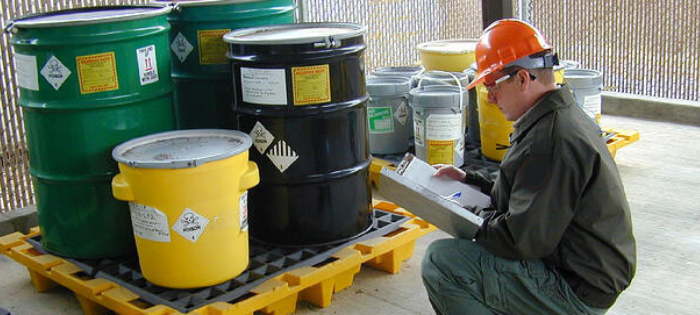
Comments: No Comments
Regulatory Alert: SQG Re-notification Requirement
EPA’s Hazardous Waste Generator Improvements Rule became effective on May 30, 2017. This Rule is designed to make the RCRA hazardous waste generator regulations easier to understand; provide greater flexibility in how hazardous waste is managed; and improve environmental protection. The final rule includes over 60 revisions and new provisions to the hazardous waste generator program.
One of these notable provisions, which impacts small quantity generators (SQG), is the requirement for SQGs to re-notify EPA or their state agency about their hazardous waste activities every four years. The first re-notification is due by September 2021. Since this is the first time EPA is requiring this of SQGs, many are not as aware of this specific re-notification requirement—and it is one that will impact many.
Who’s an SQG?
Let’s take a step back and first define who is considered an SQG. According to EPA, SQGs are those facilities that generate more than 100 kilograms but less than 1,000 kilograms of hazardous waste per month. EPA cites the following major requirements for SQGs:
- SQGs may accumulate hazardous waste onsite for 180 days without a permit (or 270 days if shipping a distance greater than 200 miles).
- The quantity of hazardous waste onsite must never exceed 6,000 kilograms.
- SQG are limited to one episodic event per calendar year (40 CFR 262.230).
- SQGs must comply with the following requirements:
- Hazardous waste manifest (40 CFR 262, subpart B)
- Pre-transport (40 CFR 262.30-33)
- Preparedness and prevention (40 CFR 262.16(b)(8) and (9))
- Land disposal restriction (40 CFR 268)
- Management of hazardous waste in tanks or containers (40 CFR 262.16(b)(2) and (3))
- There must always be at least one employee available to respond to an emergency. SQGs are not required to have detailed, written contingency plans.
And, starting in 2021, SQGs are required to re-notify EPA or their state environmental agency regarding their generator status at least every four years.
Re-notification Requirement
The intent of the re-notification requirement is to create a more accurate and complete count of the federal SQG universe, helping EPA and authorized states conduct oversight, enforcement, and planning. Ultimately, the data collected will allow EPA to identify those SQGs that are active and to remove those that are inactive from the database.
To meet the re-notification requirement, SQGs must complete and submit the Notification of RCRA Subtitle C Activities (i.e., Site Identification Form – also known as EPA Form 8700-12) or the state equivalent in full. The requirement for generators to re-notify whenever there is a change to the site contact, ownership, or type of RCRA Subtitle C hazardous waste activity conducted remains in place. Note: An SQG that submits a complete re-notification within the four years before an SQG renotification deadline would be considered in compliance with this provision.
Facilities can elect to fill out the paper form or may submit electronically via MyRCRAID, an electronic reporting system for submitting to the EPA Site Identification Form. Some states have their own forms that are equivalent to the Site Identification Form, also meeting the requirement of the regulation. In states where there is a more frequent re-notification or reporting requirement, the SQG should comply with its state deadline.
Ensuring Compliance
As generators consider this re-notification requirement and the other Hazardous Waste Generator Rule provisions, it is important to:
- Get a solid understanding of the rule for the state(s) in which the generator operates. Requirements, forms, frequency, etc. may vary from state to state and compared to EPA.
- Ensure the inventory of types and quantities of hazardous waste generated at the facility is current and documented.
- Review the Site Identification Form and determine what additional data needs to be gathered in advance of the September 2021 submittal deadline.

EHS Experts Roundtable
We recently sat down with three of KTL’s environmental, health, and safety (EHS) experts, Becky Wehrman-Andersen, Liz Hillgren, and Jake Taylor, to talk about all things EHS. The three Senior Consultants shared what they are seeing in the marketplace, as well as some of their best advice and lessons learned for managing EHS compliance.
What are some of the biggest EHS issues you see your clients facing right now?
Collectively, there are a few trends we see time and again, which generally can be tied back to many EHS “departments” (which often consist of just one person) lacking the resources—financial and personnel—to manage the sheer number of EHS requirements they are required to comply with.
We find that EHS personnel are being asked to manage a lot—and often in areas that may be outside their education/expertise/experience. So while they may have knowledge, in part, of EHS regulations, they often don’t have a comprehensive enough knowledge to always even know what they are missing. Add to this the fact that there is almost “too much” information available, and it can very quickly become overwhelming to determine what is applicable and what needs to be done to comply.
We see this creating several common scenarios:
- Entire compliance programs are being missed because customers do not realize they are subject to some requirements. In some cases, companies just don’t know what they don’t know.
- Frequently, companies may not understand the thought process of what needs to be in place to satisfy a standard’s requirements. For example, they may have OSHA training programs in place to meet requirements; however, they do not have the accompanying site-specific written programs and/or documentation that are also required for compliance.
- Often customers do not take the time or have the knowledge to identify the riskiest chemicals or processes onsite, which leads to elevated challenges in keeping employees and the surrounding environment safe.
How have you seen COVID impacting industry/your clients?
The majority of our clients have really adapted and responded to COVID as best they can. Many have remained busy and are doing just fine. However, the pandemic has resulted in operational challenges—from expanding shifts to separate people more, to having more “virtual workers,” to managing internal safety cost increases, to developing plans to juggle outbreaks. In some cases, this has slowed some policy/program development and impacted company culture. In addition, we are seeing a few companies experiencing supply chain challenges but to a lesser extent than anticipated. Understandably, there is also an element of frustration as guidance remains in flux, as well as concern as facilities “button up” for winter due to the elevated risks associated with closed spaces with little air circulation.
At the same time, companies are learning how to work with fewer people and conduct some business activities virtually. And many have been pushed into using technology that may have been available in the past but was never a necessity of doing business. Even though there have been some “bumps” in the road, people are catching on. In fact, KTL has been conducting audits, assessments, and training virtually, and our clients are seeing the benefits of a virtual approach on many levels. We anticipate some of this will continue as the new norm due to the business efficiencies it presents.
Are there any recent regulatory developments (or any on the horizon) that industry should be preparing for?
EPA has a provision as part of the 2016 Hazardous Waste Generator Improvements Rule that will be affecting small quantity generators (SQG) in 2021. The Agency is now requiring SQGs to renotify EPA or their state agency about their hazardous waste activities every four years. The first renotification is due by September 2021. Since this is the first time EPA is requiring this of SQGs, many are not as aware of the Hazardous Waste Generator Improvements regulations and this specific renotification requirement. It is one that will impact many. Read more from EPA.
Other regulatory changes on the forefront will likely depend largely on the outcomes of the election this November, and it is just too soon to predict.
Based on your experience, what are some best practices you would recommend to help companies ensure ongoing EHS compliance and meet business objectives?
- Conduct a comprehensive gap assessment to ensure you are meeting the requirements of all applicable EHS regulations. This should be the starting place for understanding your regulatory obligations and current compliance status.
- Organize your records. Know what records you need. Document your inspections and your training. Develop standard operating procedures (SOPs) so people know what to do.
- Seek third-party oversight. Having external experts periodically look inside your company provides an objective view of what is really going on, helps you to prepare for audits, and allows you to implement corrective/preventive actions that ensure compliance.
- Perform a comprehensive onsite risk assessment with associated risk minimization planning and plan/conduct annual spill drills to practice emergency response for hazardous chemical incidents.
- Create an integrated management system (e.g., ISO 9001/14001/45001, Responsible Distribution) by finding commonalities between the standards and leveraging pieces of each to develop a reliable system that works for your organization.
- Develop a relationship with someone you trust to do things in your best interest, understanding that EHS should be a process of continuous improvement. Use them to help you understand what regulations apply. Let them help you prioritize your compliance plan. Use them to do your annual training. Rely on them as a part of your team.
- Get senior leadership commitment. It is often clear how an organization prioritizes EHS with little digging. Even with the best EHS personnel, the organization and its EHS system will only be as good as the top leadership and what is important to them.
Do you have any good “lessons learned” to share about what to do when it comes to EHS compliance?
Just start! It is better to do some than none. Get organized. Determine what you need, break it down, set a schedule, use your consultant to keep you on target, and just get started. Something is definitely better than nothing.
KTL has coached several companies from a “zero to compliance” status and has also actively assisted in OSHA and EPA penalty negotiations. One company went from an anticipated $300,000 – $500,000 in penalty to ZERO penalty, reduced their generator status from large quantity generator (LQG) to very small quantity generator (VSQG), and achieved a more than 70% reduction in waste management costs simply through process changes and risk reduction strategies.
How important is technology when it comes to EHS compliance?
EHS personnel are starting to see the possibilities of how incorporating technology solutions can help them become more efficient in their operations and compliance processes. As stated above, COVID has pushed some technology innovations to the forefront as a means for companies to continue operating in different ways.
For example, technology tools can be very helpful with tracking requirements and documents—but it also requires good organization and communication. Custom apps for conducting inspections and regular checklists can be a simple way to create operational efficiencies, particularly for smaller organizations who may lack the initial financial resources to undertake an entire system implementation. Once that initial investment is made, companies often see the value of technology and the potential to implement a centralized compliance information management system to help manage and track compliance obligations, activities, and performance/status.
With technology, it is no longer a question of IF, it is just a matter of WHEN companies decide to jump on board. Technology and “Big Data” can—and should—be a focus of any EHS compliance program. The investment will pay off in the end.
What value do you see KTL providing?
We serve as an extension of a company’s EHS staff—from completing small tasks that never seem to get done to identifying large gaps in compliance and building systems to resolve those non-compliance issues. We are there to support, answer questions, provide technical knowledge, and help our customers achieve compliance. We are teachers, trainers, a sounding board, and an EHS support system. We have a great team of experts who know EHS, understand industry, and excel at creating solutions and tools to meet our clients’ needs. Trust is critical and we strive to be trustworthy. That is who KTL is.

Environment / Food Safety / Quality / Safety / Technology Enabled Business Solutions
Comments: No Comments
Functionality for Today…Flexibility for the Future
There is no question about it—organizations across nearly every industry are relying more heavily on information technology (IT) to carry out daily tasks, connect staff, and manage operations. Technology can also play a vital role in managing compliance requirements.
For example, we recently shared a case study demonstrating how leveraging a simple Microsoft SharePoint®-based Compliance Management System (CMS) has provided Southeast Missouri State University (SEMO) with access to the data, documents, systems, and processes required to help employees effectively manage compliance requirements—even when working remotely.
Tips to Design a Successful CMS
A CMS is used to coordinate, organize, control, analyze, and visualize information to help organizations remain in compliance and operate efficiently. When building a CMS, it is important to follow a process to design a system that provides the functionality to meet current requirements and the flexibility to anticipate future needs.
The following eight tips can help ensure you end up with the right CMS and efficiency tools to support your organization for the long term:
- Inventory your existing systems – Identify how you are currently managing your compliance needs/requirements. What’s working well? What isn’t working? Do the systems work together? Do they all operate independently? This inventory should evaluate the following:
- Current systems and tools
- Status and functionality of existing processes
- Data sources and ability to pull information from various sources
- Organizational complexity
- Compliance status
- Existing management systems
- Determine your business drivers – Are you looking to save time? Create efficiencies? Provide access to enable employees to work from home? Reduce the number of resources required? Have better access to real-time information? Answer to senior management? Respond to regulatory requirements? These drivers will also drive the decisions you make when it comes to module development, dashboard design, reporting, and more.
- Understand the daily routine of the individuals using the system – Systems and modules should be built according to existing daily routines, when possible, and then implemented and rolled out in a way that encourages adoption. Having a solid understanding of routine tasks and activities will ensure the system is built in a way that works for the individuals using it—and for the way they will be accessing it.
- Understand your compliance requirements – Do you have permitting requirements? Does your staff need training? How do you maintain your records? Are there regular (e.g., annual, semi-annual) plans and/or reports you need to submit? Do you have routine inspections and monitoring? All these things can and should be built into a CMS so they can be managed more efficiently.
- Get the right parties involved – There are many people that touch a CMS at various points in the process. The system must be designed with all these users in mind: the end user entering data in the field, management who is reading reports and metrics, system administrator, office staff, etc. A truly user-friendly system will be something that meets the needs of all parties. If employees are frustrated by lack of understanding, if the system isn’t intuitive enough, if it is hard to put data in or get metrics out, the system will hold little value.
- Make your wish list – While you may start your project one module at a time, it is important to define your ultimate desired end state. In a perfect world, how would the CMS operate? What parts and components would it have? How would things work together? What type of interfaces would users have? You may build piece by piece, but you must develop with the end in mind.
- Set your priorities, budget, and pace – What is the most important item on your list? Do you want to develop modules one at a time or as a fully functional system? It often makes sense to start where you already have processes in place that can be more easily transitioned into a new system to encourage user buy-in. Priorities should be set based on ease of implementation, compliance risk, business improvement, and value to your company.
- Select the right consultant – For a CMS, it is valuable to have a consultant who doesn’t just understand technology but also understands your operational needs, regulatory obligations, and compliance issues. More than likely, off-the-shelf software will not be a silver bullet compliance solution. A consultant who can understand the bigger picture of where you want to go and will collaborate to design the right CMS and efficiency tools will bring the most value to your organization.
These tips can help ensure any organization designs and develops the right CMS—one that works within the organization’s operating environment—to reduce compliance risk, create efficiencies, provide operational flexibility, and generate business improvement and value.
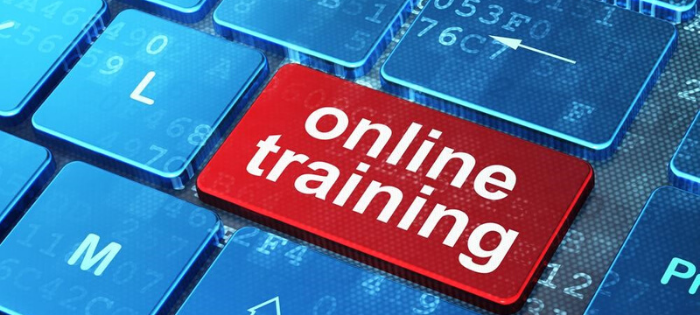
Taking Training Virtual…Or Not
Over the past several months, many companies have had to prioritize business activities given restrictions on travel and social distancing guidelines. Despite these restrictions, however, certain compliance activities are still required, including training.
Training is a key component for maintaining ongoing compliance—whether with regulatory requirements, supply chain mandates, or internal policies. While some training can be postponed, putting training on the backburner can have its consequences, ranging from unprepared employees, to noncompliance, to preventable injuries or worse.
Much like with audits, there are alternatives to meeting training requirements and ensuring employees are well-instructed and prepared to do their jobs, even with current government and/or company restrictions. Online and virtual training are not necessarily new options, but their popularity is most certainly on the rise. In-person, online, and virtual training can all provide quality options if you understand your training needs and understand what type of training works best in different scenarios.
Face-to-Face
As we have experienced, sometimes there is no substitute for doing things face-to-face. For certain types of training, in-person is clearly the best alternative for a number of reasons:
- It is designed for people who need to genuinely know the material inside and out and for those who would benefit from a more tailored, interactive learning experience.
- With in-person training, learners are able to ask specific questions and get them answered immediately.
- In-person training provides a focused, immersive learning experience, where attendees can have interaction, discussion, and live input.
- Trainers get to know attendees and can adjust training (e.g., material, learning speed, examples) to the group’s learning style.
- In-person training allows attendees to develop relationships with the trainer and other attendees, which can prove beneficial on future projects.
As many organizations have discovered, particularly lately, while in-person training may offer a great alternative, it is not always possible. Beyond travel and social distancing restrictions, in-person training can also be cost-prohibitive. In addition, scheduling of in-person training can present more challenges, as timing is based on the instructor and is not flexible.
Best suited for: Multi-day classes where demonstration of competency is needed, and participants are building skills they will use frequently; introductory classes where participants need to understand new material.
The Online Option
At the other end of the spectrum, we have online training (not to be confused with virtual, which is discussed below). Online training involves an online module that allows participants to watch and/or listen to a pre-recorded class. Generally speaking, online training works best when individuals already know the material (e.g., refresher training) and is most appropriate when the attendee does not have to be an expert in the subject matter (i.e., awareness level vs. functional expertise).
In addition, online training is generally cheaper since it is not customized and does not require travel or an onsite trainer. It can also be faster and more flexible, as attendees can work at their own pace and have the ability to pick their own schedule.
While there are certain benefits to online training, it is not suitable for all types of training. Because online training does not involve a live instructor, attendees are generally unable to ask questions effectively and there is little opportunity for follow-up input on areas covered. This is no opportunity for hands-on learning and interaction. For example, something like 24-hour HAZWOPER training would be difficult to do as an online course, as a hands-on component is valuable in helping participants demonstrate competency, as required. Finally, because of a potentially diverse audience, online training tends to be generic and not tailored to the specific needs.
Best suited for: Courses where participants have had many, many years of experience and just need refreshers, such as HAZWOPER 8-hour, DOT General Awareness, or RCRA refresher training.
Taking It Virtual
Finally, virtual training provides a bridge between online and in-person training. Like online training, virtual training is done via technology (e.g., Zoom, WebEx); however, it takes place live with instructors engaged in the training as it is occurring. Virtual has many of the same advantages as in-person training since it is being done live. Learners can get more in-depth training and benefit from live interaction, questions, and discussion to help develop specialized expertise. Virtual training works best when travel is limited but students still need to have real-time input from the instructor.
That being said, virtual training cannot completely replace in-person training. With screens, it may be difficult for the trainer to read the crowd and accurately interpret learning needs. Hands-on opportunities become more limited—though not impossible—and require cooperation, coordination, and open-mindedness from all attendees. Finally, technology and logistics are critical for this type of training. A computer with good internet access is critical. If internet connections are slow or sound quality is poor, training can quickly become ineffective.
Best suited for: Refresher training (as with online options), more detailed training that can be customized to the specifics of the class (i.e., site-specific, industry-specific), or training for those with less experience who may need to ask questions.
Consider Learning Styles
People learn very differently. Some people are aural learners and can hear material and develop understanding. Others are visual learners so just reading material on a screen “sticks.” Others are tactile learners and need to participate in physical interaction to understand content. It is important to keep this in mind when choosing the best platform, as well:
- With in-person classes, all learner types can be addressed.
- With online classes, typically only visual learners retain the information unless there is audible training coordinated with the material.
- With virtual learning and coordination with the site prior to the training program, all three learner types can be addressed.
While some training can be rescheduled with minimal impacts to the business, many training requirements cannot. Companies need to know their workers are retaining the information, particularly given OSHA requirements that employees must demonstrate understanding and competency. To ensure that training not only “checks the box” but is also effective, it is important to evaluate not just the training, but the delivery options. In-person, online, and virtual all have their strengths based on the training needs and individual learning styles.

Environment / Kestrel Tellevate News / Safety / Technology Enabled Business Solutions
Comments: No Comments
KTL Renews Agreement to Provide Access to EHS Regulatory Question Modules
KTL is pleased to announce that we have renewed our agreement with the Construction Engineering Research Laboratory (CERL) of the U.S. Army Corp of Engineers, which provides access to the following regulatory question modules:
- The Environmental Assessment and Management (TEAM) Guide and the related state supplements address environmental compliance in the areas of air quality, cultural and natural resources, hazardous materials and waste, pesticide management, pollution prevention, energy conservation, petroleum, oils and lubricants, storage tanks, solid waste management, toxic substances, water quality, and more.
- The Occupational Safety and Health (OSH) Guide is used in assessing compliance with the standards of the Occupational Safety and Health Administration (OSHA). It may also be used in combination with an agency-specific safety and occupational health manual. The OSH Guide is based on OSHA regulations from Title 29 of the Code of Federal Regulations.
KTL originally entered into this agreement with CERL in 2015. CERL’s experts are dedicated to conducting ongoing research, updating federal and state environmental and federal safety regulatory requirements, and developing and maintaining standardized audit checklists for those regulations. These checklists are very comprehensive; are used by auditors for DOD, DOE, DOI, and other federal agencies; are updated regularly to reflect any regulatory changes; and cover virtually all of the functions that would be present in a broad mix of industrial companies.
Our agreement allows KTL to make the TEAM Guide and OSH Guide available through an electronic format (i.e. dynaQ™). KTL staff can use these modules to stay current on changing federal regulations. The question modules bring a basis of significant credibility related to the reliability and completeness of audit content via a software tool that manages audit data and makes finding information more efficient. With this agreement, KTL remains one of the only professional service firms in the country to offer access to the following regulatory question modules.
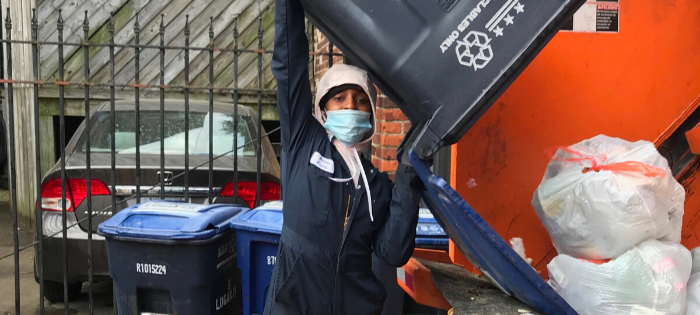
Comments: No Comments
COVID-19 & Emerging Best Practices for Waste Management
The COVID-19 pandemic has had tremendous impacts on various industries and sectors—most have had to adjust business practices (in small or large ways) to meet new guidelines for safe operations. At times, it may seem impossible to keep up with the latest developments/recommendations and their impacts on day-to-day operations.
A cross-cutting issue for almost every business (and every household) is the safe and proper management of waste. Almost all our activities generate some form of waste. During an infectious disease outbreak such as COVID-19, it becomes increasingly important to ensure the provision of safe water, sanitation, and hygienic conditions to help prevent human-to-human transmission of the virus.
Updated Guidance
State and federal agencies throughout the U.S. and abroad, as well as international organizations, have begun to issue new and/or update existing guidance regarding proper waste management practices as experts learn more about the COVID-19 virus (SARS-CoV-2). The U.S. Occupational Safety and Health Administration (OSHA), for example, recently issued guidance stating that, “Generally, management of waste that is suspected or known to contain or be contaminated with COVID-19 does not require special precautions beyond those already used to protect workers from the hazards they encounter during their routine job tasks in solid waste and wastewater management.” However, state, tribal, and local governments may follow stricter guidance.
Similarly, the World Health Organization (WHO), in its April 2020 revised Interim Guidance, noted that there is “no evidence that direct, unprotected human contact during the handling of healthcare waste has resulted in the transmission of the COVID-19 virus.” The WHO further states that the usual best practices for the safe management of infectious waste should be exercised.
Best Practices to Minimize Risk
The OSHA and WHO guidance highlight an important point—where existing processes and systems can safely be relied upon for the proper management of waste during this pandemic, organizations should avoid making changes. Where the nature of COVID-19 requires adjustments, that is where organizations should focus their efforts.
Outlined below are some general best practices that organizations should consider implementing to minimize risks associated with waste management during COVID-19 and beyond:
- Municipal Waste: Workers and employers should manage municipal (e.g., household, business) solid waste with potential or known COVID-19 contamination like any other non-contaminated municipal waste. Workers should prevent exposure to waste through safe work practices and approved Personal Protective Equipment (PPE), such as puncture-resistant gloves and face and eye protection. To help protect sanitation workers, the Idaho Department of Environmental Quality (DEQ) advises households with waste suspected to be infected with COVID-19 tightly enclose waste in heavy-duty bags, double-bag the waste, and ensure that curbside containers can close completely. As always, anyone handling waste should wash hands thoroughly.
- Healthcare Waste: Healthcare waste with potential or known COVID-19 contamination should be managed like any other regulated medical waste. In the U.S., COVID-19 is not a Category A infectious substance. Again, use typical engineering and administrative controls, safe work practices, and PPE to prevent worker exposure. Although not required, the Healthcare Waste Institute (HWI) recommends COVID-19 waste be identified to protect workers in the event a bag needs to be re-opened. Only grossly contaminated PPE should be placed into sealed bags (red bags in the U.S.). Tissues or similar materials used by patients when coughing or sneezing should be immediately disposed of in a lined waste receptacle, and then correct hand hygiene should be performed. Such waste may be disposed as regular trash (i.e., municipal solid waste), unless otherwise directed by local health departments. Public Health England, for example, advises that such waste be double-bagged, tied securely, stored separately from other waste, and left for 72 hours before sending for disposal as standard municipal solid waste.
- Recycling: As with municipal waste, employers and workers in the recycling industry should continue to use typical engineering and administrative controls, safe work practices, and PPE to prevent exposure to recyclable materials they manage, including any contaminants in the materials. Organizations and households should always refer to their local recycling hauler’s guidelines to determine if and what products can be recycled. The U.S. Environmental Protection Agency (EPA) is advising individuals to treat recyclables as trash if anyone in their home has COVID-19.
- Wastewater: Coronaviruses are susceptible to the same disinfection conditions as other viruses, so current disinfection processes in wastewater treatment facilities are expected to be sufficient, per OSHA and the Centers for Disease Control and Prevention (CDC). This includes practices such as oxidation with hypochlorite (i.e., chlorine bleach) and peracetic acid, as well as inactivation using ultraviolet irradiation. There is no evidence to suggest that additional, COVID-19-specific protections are needed for employees involved in wastewater treatment operations.
- General Hygiene and PPE: As currently recommended by all agencies, improved personal hygiene, particularly adequate handwashing and the use of adequate PPE (e.g., masks, gloves, eye protection), offers the greatest protection against COVID-19, including transmission through waste. Staff handling waste should be properly trained, use approved PPE, and maintain good hygiene.
As with many facets of this pandemic, regulatory requirements and best practices are subject to change as we continue to learn about the virus and its transmission. KTL can help you monitor these developments and understand which requirements and guidance apply to your operations—both in the U.S. and abroad.
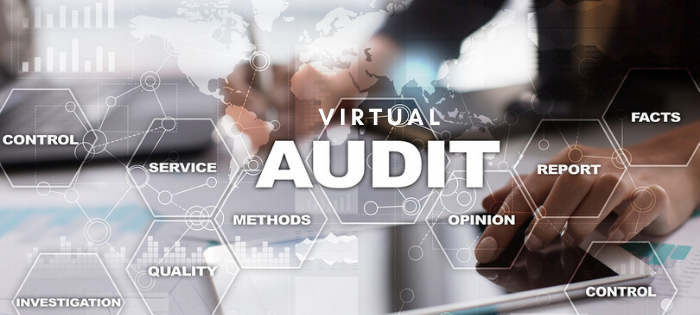
Virtual Audits: Best Practices to Make Them Work
Audits provide an essential tool for improving and verifying compliance performance. Audits may be used to capture regulatory compliance status, management system conformance, adequacy of internal controls, potential risks, and best practices.
Most regulations, standards, and guidance require audits to be conducted with some established frequency. For many companies, figuring out how to meet these audit requirements amongst travel restrictions, new company safety protocol, and government quarantines related to COVID-19 presents a significant new challenge.
The Online Alternative
Companies come in a variety of sizes with a range of different needs. Because of this, auditing standards remain fairly flexible by design. Fortunately, this allows for online/remote/virtual audits as a viable alternative to onsite audits—provided the audits:
- Are planned well;
- Appropriately leverage technology; and
- Are executed by a team who understands the facility and the requirements.
The ultimate objective of a virtual audit remains the same as an in-person audit: To obtain credible audit evidence to accurately assess compliance/conformance with identified requirements/specifications. The difference lies in the means in which that evidence is collected (i.e., live stream video, surveillance cameras, group web meetings, electronic document review).
Weighing Risks vs. Rewards
Audits can be conducted onsite, remotely, or a combination of the two. In many cases, companies may already be having portions of the audit (e.g., document review) done remotely. Moving the entire audit to the virtual world allows credible evidence to be obtained in unique ways that can offer significant benefits to a company when onsite audits aren’t possible—and even when they are:
- Reduced cost – Online audits eliminate the expenses associated with travel (i.e., mileage, flights, hotels, meals), which can add up depending on the location and duration of the audit.
- Flexible schedule – Remote audits can be conducted on a more flexible time schedule. Auditors do not have to complete work onsite in a set number of days, as is required when traveling to a facility. The auditor can also review areas in question remotely after the audit is technically over. Note that a more flexible time schedule does not necessarily mean less time involved to conduct the audit.
- Social distancing – As CDC guidelines have recommended, it is currently safest to work remotely, when possible, or to remain six feet of social distance to avoid potential transmission of COVID-19. Through the use of technology, virtual audits provide a social distancing extreme.
- Improved systems – Preparing for a virtual audit provides the “push” some organizations need to improve electronic storage systems. To conduct a virtual audit, documents and records must be retained in an organized manner that facilitates easy/quick access. Being able to access all documents remotely is necessary—paper records or documents stored on individual computers/network drives no longer cut it.
At the same time, there are some potential risks to conducting a completely virtual audit, particularly since this practice is relatively new to many organizations:
- Observation/technology limits – Observation of site conditions is limited by the ability to direct live stream video remotely. Technology can create limitations. If the camera can’t see it, neither can the auditor. Poor video quality can impede visual clarity. You don’t know what you don’t know.
- Communication confusion – It can be difficult to read body language and/or interpret emails and phone conversations to make sure communication is clear. This can require revisiting topics/findings several times to ensure accurate evidence is collected.
- Time barriers – There may be time zone and associated scheduling barriers depending on the location of the auditor and the facility.
Considerations and Best Practices
Regardless of the type of audit a facility conducts (i.e., remote, onsite, combination), standard audit best practices should be followed to ensure that audit results are comprehensive and credible. If the company opts for a virtual audit—for any reason—there are a number of considerations and best practices to ensure that the audit effectively fulfills its objectives and alleviates the risks outlined above to the extent possible:
- Site Familiarity – Virtual audits work best if auditors are familiar with the industry and/or operations. While it is not necessary for the auditor to have visited the site before, that type of familiarity with the facility provides the best-case scenario, especially for compliance audits, as it prepares the auditor to know what to look for (and where) and what questions to ask.
- Careful Planning – Much like onsite audits, virtual audits require careful upfront planning on the part of the auditor and the facility—and perhaps to an elevated degree.
- The facility needs to collect all documents and records prior to the audit and determine best way to present that information remotely (e.g., email/transfer ahead of time, allow access to company Intranet/shared directory space, share during a web meeting).
- Interviews are best scheduled in advance to ensure availability; however, they can be conducted on an ad hoc basis as need arises.
- It is best to plot out route and areas of specific focus for the audit ahead of time using a site map as a guide to ensure that all areas are covered and that the audit can be conducted as efficiently as possible using the allocated facility resources. An audit site guide must be assigned who is familiar with the entire facility.
- Technology needs and requirements must be evaluated, and logistics and access should be tested prior to the audit. It is vital that all cameras, web meetings, shared document space, WiFi, and other technology is working appropriately prior to the audit or a lot of time can be wasted troubleshooting issues.
- Video – Videos should be live. Site walks should be led by a site guide/employee along the planned route with smart phones, iPads, etc., with live streaming capabilities. It is important to ensure that live streaming works within the facility being audited so auditors have a clear view of site conditions. Auditors can also take advantage of any in-house surveillance cameras (e.g., security or quality systems) to provide additional footage of operations, when necessary. In most cases, surveillance footage cannot replace live video.
- Web Meetings – Opening, closing, and daily briefings can be conducted via web meeting. Remote audits provide the flexibility to conduct the audit in segments, with briefings following each segment. This allows the auditor to review video footage, evaluate records, and generate questions to ensure the information collected is accurate and complete.
Companies all over the world are working through a transition period right now, where they are trying to establish what a new “normal” looks like when it comes to operating practices, employee health and safety, business continuity, and compliance. Audits are one piece of the overall puzzle that can be transitioned somewhat seamlessly with the right planning and technology in place to ensure ongoing compliance.
